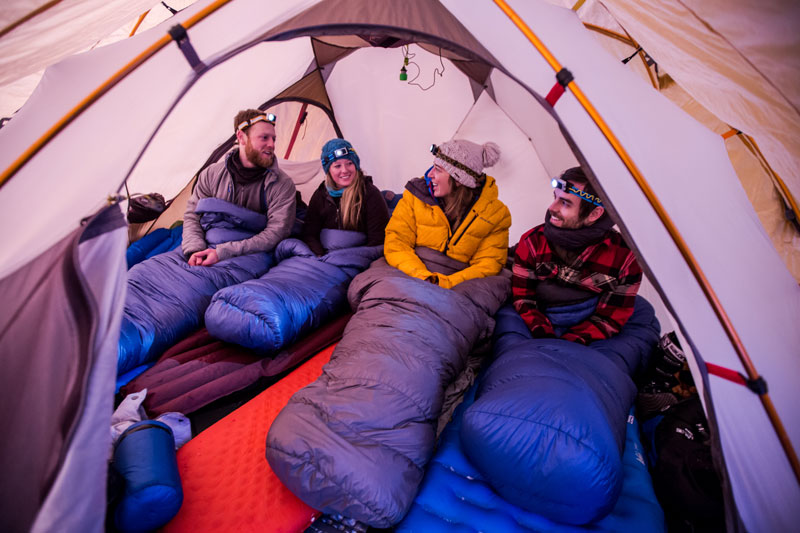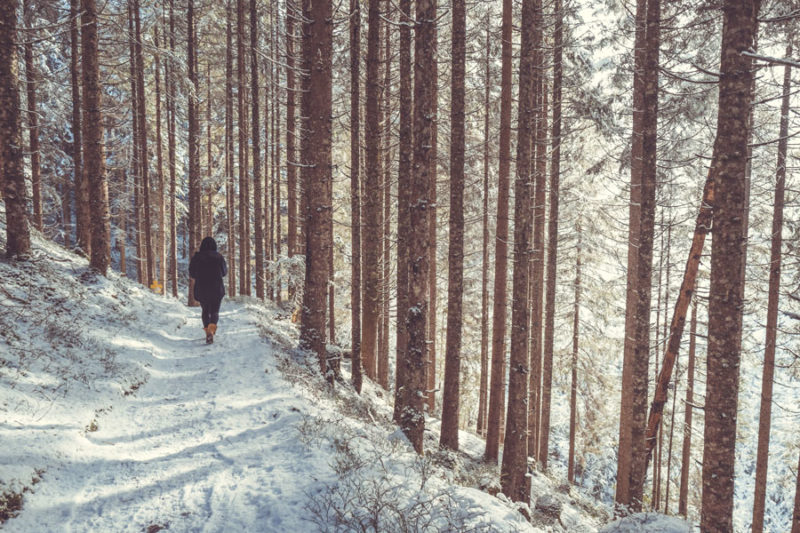
Make Cold-Weather Camping SO Much Warmer – 7 Tips

Cold-Weather Camping Is Worth It!
Ahh, cold-weather camping. There’s so much to love about it: uncrowded trails and parks, getting the first choice of campsites anywhere you go and enjoying fresh, hot coffee as you watch the morning fog lift right outside your tent. yup.
However, there’s one thing that’s not so great about cold-weather camping: being cold. Not only is it uncomfortable, but it can also have a negative impact on your trip: if you’re too cold to sleep through the night, you can bet you’re going to be too tired the next day to hike miles on end.
To make your next trip a little more pleasant, we’ve put together this list of ways to stay warm while cold-weather camping. Whether you’re camping in the middle of December or just setting up your tent in a region with major nighttime temperature drops, here’s our list of seven ways to make cold-weather camping much warmer.
Stay warm with proper ventilation

We know it sounds counter-intuitive – why would you want to sleep in a tent with what essentially amounts to holes in it? For this one, we have to dive (just a little) into the science: when you sleep, the warmth of your body against the chilliness of the air outside causes condensation – aka, little droplets of water in your tent. If you don’t have vents in your tent, those little droplets will run down the sides of your tent and end up soaking into whatever is on the floor, including your sleeping bag. The only thing worse than waking up cold is waking up cold and wet.
Get off the ground

For this one, there’s no science required: the ground is cold, so don’t sleep on it. Adding an inflatable mattress pad to your camping setup serves two purposes: it eliminates contact between your body and the cold bottom of the tent, and it adds a layer of warm air under your body. Sleeping pads are measured in “r-value;” the higher the r-value, the warmer the pad and the better it will be for cold-weather camping. Modern sleeping pads pack tightly into their own stuff sacks so even backcountry campers will find them easy to carry.
Don’t waste time making your fire
When cold_weather camping, it is essential to get your fire started before it gets dark. Starting a fire can be a slow process, and you want yours to be roaring before the sun goes down so it’s roaring before you get cold. Make sure you bring fire-starters that are easy to use and, ideally, waterproof. In the winter, any firewood and kindling you find is likely to be wet, either from snow and rain or from cold-weather dew – so you’ll want to bring a firestarter with a long burn time since damp wood doesn’t light easily. Sweetfire Firestarters from UCO is a great option as they have a strike-able tip, meaning they are as easy to use as matches. Some options even burn for up to 15 minutes, so you’ve got plenty of time to get that kindling burning. Firestarters are essential cold-weather camping gear.
Embrace Duct Tape
In the winter, metal is better than plastic for cold-weather camping – plastic can crack if it gets too cold. But holding metal tools for even a few seconds can make your hands too cold for comfort. Before heading out on your next trip, wrap anything metal in duct tape, including utensils, fuel containers, water bottles, and more. If you are in the market for a new torch, UCO offers an awesome butane torch that comes wrapped in duct tape. Your hands will thank you, and plus when have you ever not needed duct tap?
Leave the cotton at home

Sure, there’s nothing better than sleeping in your favorite tee and flannel pants. When cold-weather camping the goal is to retain body heat, and for that cotton is a terrible choice. Cotton absorbs water, which means the second you start to sweat or perspire while sleeping, your shirt is going to absorb that moisture – and as we all know, nothing makes you colder quicker than wet clothing. In addition, whatever you are sleeping in should tight fitting. This allows moisture to be absorbed by the fabric instead of sitting on your skin. Choose fabrics that are specially designed to pull moisture away from your skin and encourage evaporation, which usually means synthetic (i.e: man-made) fabrics. Merino wool is an organic fabric with similar properties, though it can often be more expensive than synthetics. Base layers intended for skiing make great cold-weather camping pajamas.
Choose the right campsite
A great advantage of cold-weather camping is that you’ll probably have your pick of available campsites. But you don’t want to make a decision based on the views alone. Tall brush and bushes will help block wind, which creates a warmer spot in which to sleep or start a fire. Sunshine can also make a difference, so pay attention to where the light is when you arrive at the campsite. If you’re able, choose a spot that’ll get blasted by morning sun as soon as day breaks. The moment just before the sun comes up is the coldest part of the night. You can effectively shorten that period of extreme cold by making sure your tent is in an area that is the first to receive morning sun.
Put your extra clothes to work

You don’t have to be wearing clothing for it to keep you warm. Before crawling into your sleeping bag at night, leave items you’re not wearing in an easy-to-reach spot. If you find your feet getting extra cold, lay a sweatshirt or down jacket across your feet over your sleeping bag. Or, if you find your sleeping bag is a little too roomy, you can even ball up clothing and shove it down into your sleeping bag. This reduces the amount of space in your bag, which better traps your body heat (and provides a little extra insulation!)
With these cold-weather camping tips, you’ll be ready to conquer the trails any time of year.

Explore more award-winning fire-starting tools perfect for cold-weather camping here: https://www.ucogear.com/firestarters/






